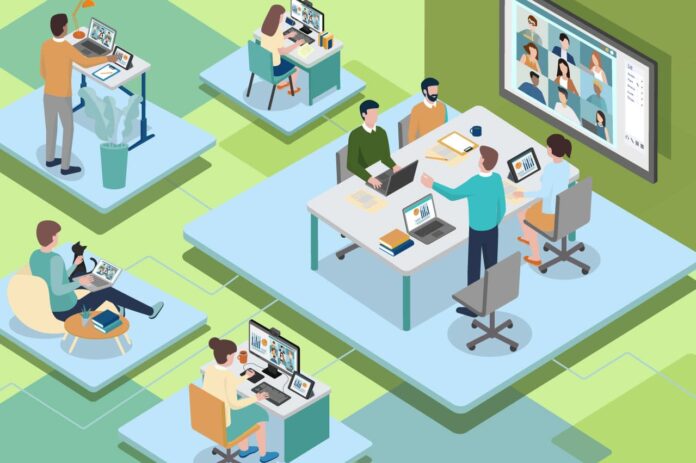The situation generated by the pandemic has produced a new hybrid working model, or, depending on the geographical or economic area, has boosted it. Beyond the technological elements that facilitate this hybrid model, team leaders find themselves facing a new scenario where they must develop new mindsets and skills.
Is it possible to ensure that these leaders of the organization will efficiently and effectively support the long-term model change?
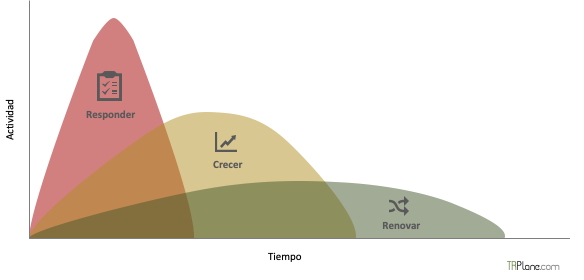
Until now, organizations have had to give a rapid response to a scenario forced by the global health crisis. The challenge is to be capable of a return to normality and growth and the consequent renewal derived from this model.
1.- The new commitment of people and the hybrid model
In the hybrid work model, the first thing to consider is the relationship between the organization and the people who make it up, as well as the model itself. This leads to a new commitment between the parties that could be summarized in these three principles and strategies:
- Shared purpose between the organization and the people that goes beyond written messages, to behaviors, improving the attractiveness of the position and therefore the commitment to the labor market.
- The deeper relationships between employees, their families and their communities improve performance.
- La radical flexibility about where, when and how hard you work can significantly improve performance.
The hybrid model ensures that work has the ability to flow across various workplaces or workspaces and hours, ranging from remote solo sites, to small-town microsites, to traditional concentrated facilities (office, factory, retail, etc.). The model is flexible, adaptable and co-owned by organizations and individuals.
Due to its influence on the evolution of the entities, the model map must flow, and one of the most critical points will be to take advantage of the opportunity to ensure the capacities of leaders and managers to take advantage of this new reality.
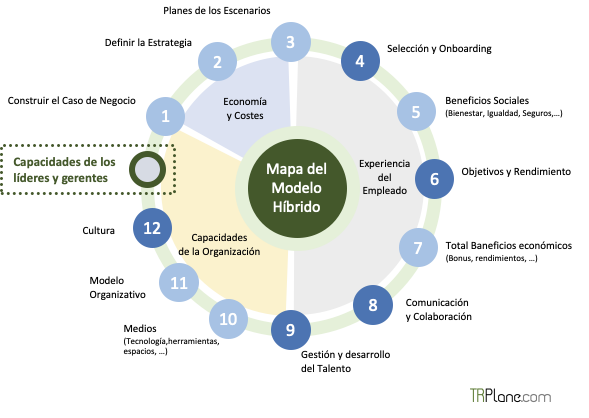
2.- Defining the opportunity for new leaders
It is customary, before the hybrid work model, to hear comments like the ones shown below.
“What worries me the most is innovation. Innovation is hard to program, it's impossible to program." (Ellen Kullman, CEO of 3D printing company Carbon Inc.)
"Working on a hybrid model...has developed me as an adaptable leader who thrives being outside of my comfort zone." Denis Canty, global vice president of McKesson)
"You lose a lot. … Culture, character, learning — you can't do a lot of that remotely." (Jamie Dimon, CEO of J.P. Morgan Chase)
"When you can't see people working, you have to trust people to do their jobs...you may be surprised what can happen when you give people the freedom to control their workday." (Ingrid Ødegaard, co-founder of Whereby)
Given these realities, what distinguishes the leader capable of facing a hybrid work model?
Mentality
Skills
Leaders' belief that flexible work models can improve employee productivity and engagement and openness to:
- ability to perform cultural adaptation
- hybrid behaviors and modeling of new roles
- experiment to improve the employee experience
- explore new technologies to improve working methods

The ability of leaders to build trust, empower employees, support collaboration and establish productive environments for the team by taking advantage of:
- clarity of roles and objectives
- Performance management
- effective communication
- focus on connections and networks
- use of technology
- active formation of teamwork norms
The challenge is to develop or complement the necessary mindsets and skills in those leaders.
3.- A critical step: Initial Diagnosis
In order to make a diagnosis, the first thing to do is define what is being sought with said diagnosis. If the objective is to identify that hybrid mentality among the leaders.
As seen in the table above, hybrid mindset leaders are those who believe that flexible work models can improve employee productivity and engagement and are open to:
- ability to perform cultural adaptation
- hybrid behaviors and modeling of new roles
- experiment to improve the employee experience
- explore new technologies to improve
Despite the firm belief of leaders and managers that the path is a hybrid model, in most cases the perceptions are incorrect for both managers and their teams.
64%
Of leaders and managers say that the performance of workers in the office is superior to those who work remotely.
41%
Of employees who exceeded performance expectations for the company have done so remotely, compared to 24% who have never worked remotely.
Faced with this situation, a mentality open to the hybrid model is a great opportunity easy to recognize as it is characterized by the drive, agility, ownership, responsibility and long-term thinking.
Some of the challenges that this type of leaders with this mentality face are:
- How can I help people on my team to self-direct
- How to Address Barriers to Productivity in the Workplace
- How to help the team establish new ways of operating and norms for the hybrid future
- What technology can be leveraged to improve collaboration
- What have I learned during the last few months of leading remotely?
In contrast, a hybrid model closed mindset is characterized by fear of the unknown, negativity, and short-term thinking.
These leaders ask themselves the following types of questions:
- When will you finally be able to return to the office?
- How to Manage What You Can't See
- When will Human Resources provide further support and guidance
- How to preserve the culture of the organization if remote work becomes permanent
- What new platform to deal with now
- When will the remote work issues we've been involved with be overcome?
The challenge in mindset is to identify what is the predominant trait in each leader or manager. Knowing your vision on generic key aspects are easily recognizable.
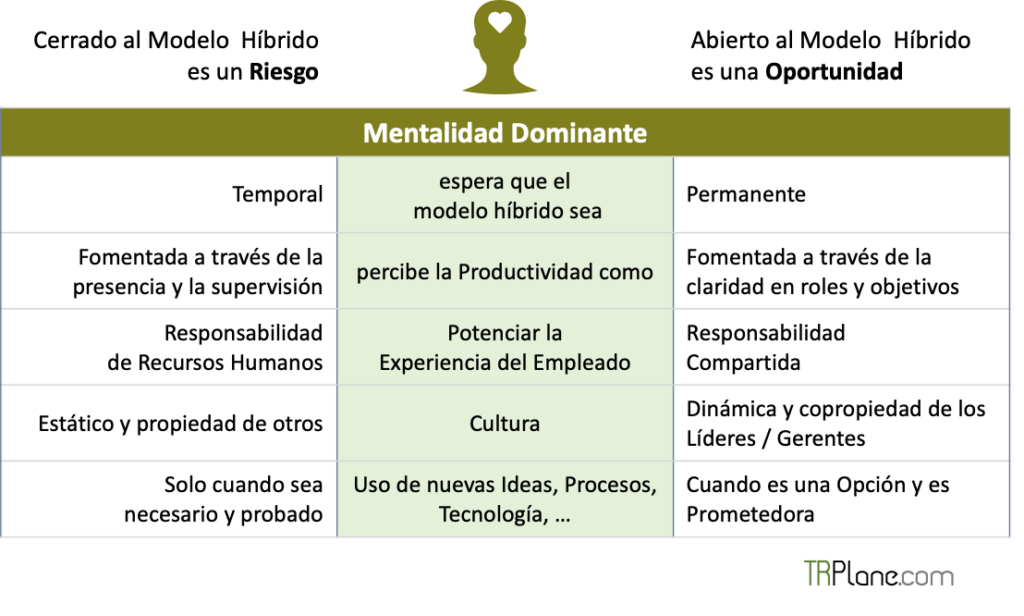
Once the leaders with the greatest potential have been identified, it is necessary to develop or deepen certain skills and foster the aspects where they must give up control versus a position of making their own and taking on a more proprietary role.
| give up control... | y Assume Responsibility and Ownership |
| Schedules and planning | Result |
| Working hours | Culture and Methodologies |
| Work space | Team climate and well-being |
| Tasks and Activities | Change management |
4.- Definition of the Skills for the Hybrid Model
As previously mentioned in point 2, the skills of leaders in the hybrid work model are based on their ability to build trust, empower employees, support collaboration and establish productivity environments for the team, taking advantage of:
- clarity of roles and objectives
- Performance management
- effective communication
- focus on connections and networks
- use of technology
- active formation of teamwork norms
The impact of developing these skills results in real and tangible benefits. For example, the Innovation Effectiveness It is directly related to the empowerment of people.
+12%
of employees with greater visibility in informal networks
+22%
guide colleagues on proactive use of networks
La Innovation Effectiveness it is defined as the degree to which an organization is effective at identifying new opportunities, determining which ones to pursue, and adjusting business processes to act on them.
The skills of a leader that are needed are not new, simply by adding the remote or virtual factor they are complemented or developed in the new relationship media.
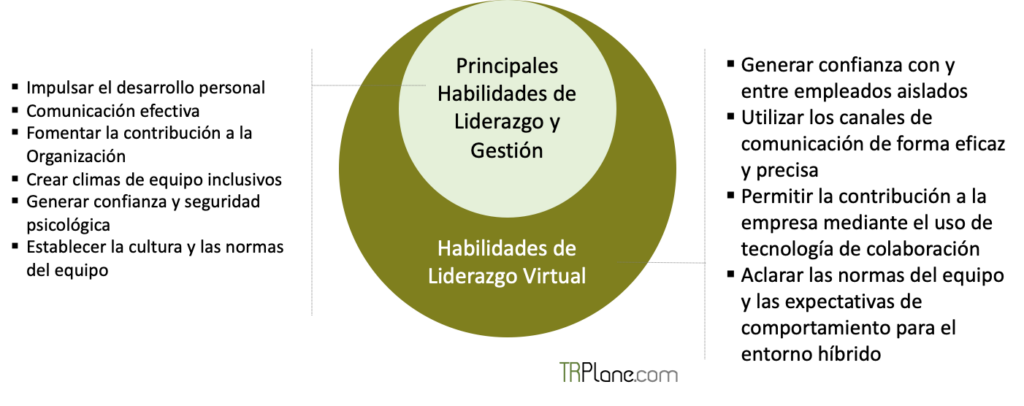
The challenge is to develop skills adaptively according to the circumstances of the people and the needs of the business.
- Set appropriate goals when employees have personal or family issues (children, elderly, etc.)
- Delegate effectively when working hours are flexible
- Building a Productive Culture Appears Burnout from Virtual Meetings
- Ensuring that employee contributions are visible, when they are not present in the offices
- Conflict resolution due to different schedules and expectations
- Intentionally fostering camaraderie, when it doesn't come organically
- ...
Once the key skills have been identified, a first diagnosis of the people is carried out to find out the central challenges that will be necessary to face in each one of them. The following table can serve as a model for illustrative purposes.
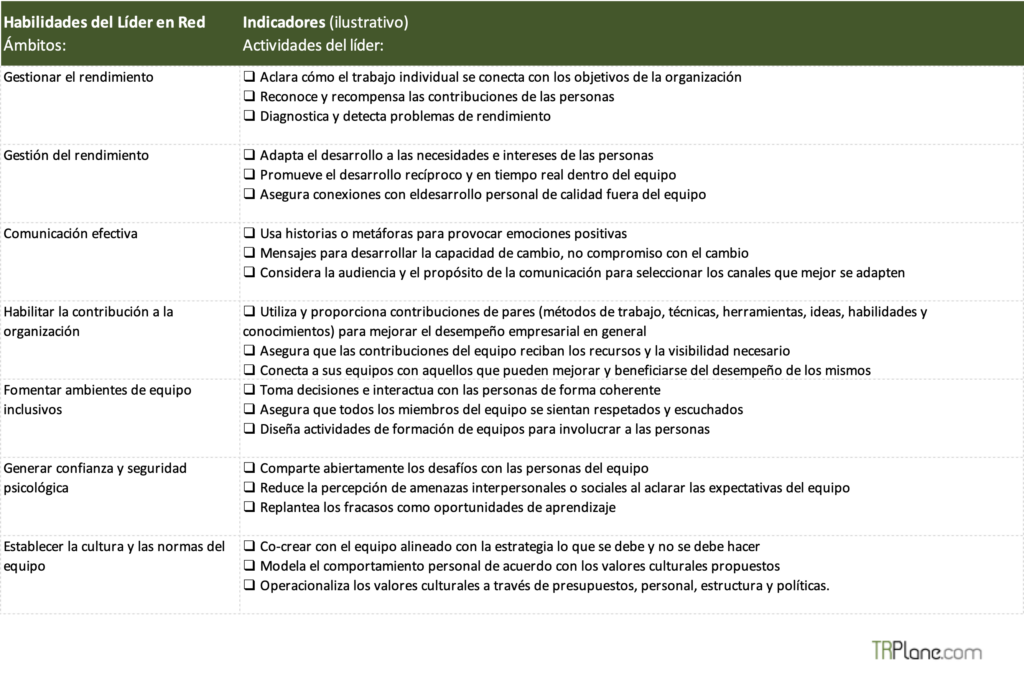
In addition to the more vertical vision of his team, he must also be aware of his relationship with other currents in the market and opinions in the organization, in an adaptive way to adjust to these new inputs of information or improvements.

A flexible leader with the ability to adapt has a 21% higher performance than the rest.
Adapting the Leadership Plan
For maximum efficiency, the plan would be a segmentation of potential leaders for a hybrid work model according to their development priorities.
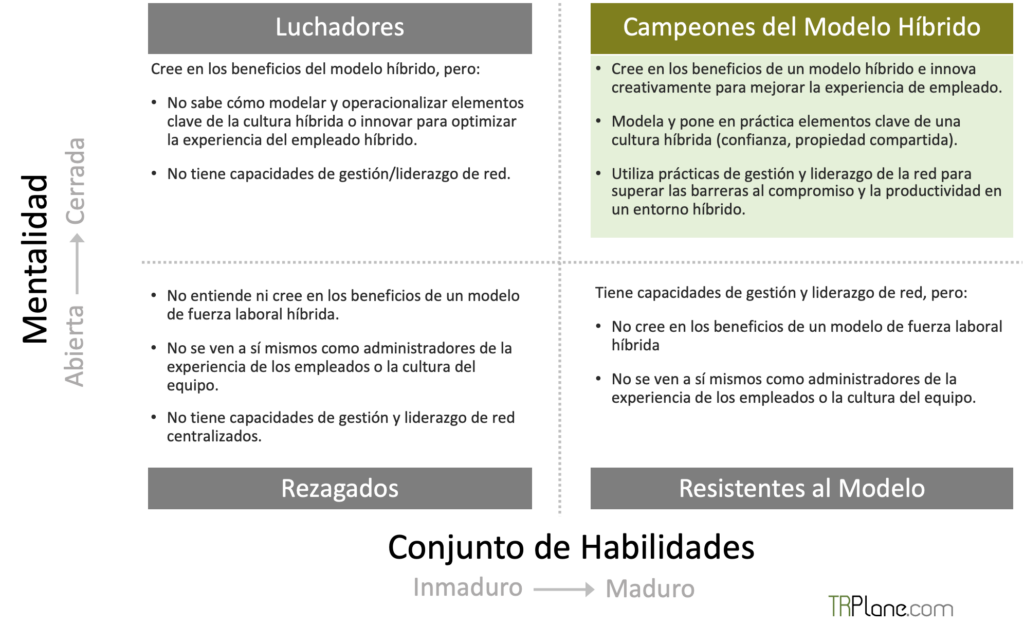
Once the segmentation is done, it helps to focus, both from a mindset and skill development standpoint on the basic levers.
- Self-knowledge of the person
- Peer and peer support
- Feedback and sustainability of the model
To build the first lever internally, the self knowledge, a good practice could consist of 3 levels showing leaders the change
- Socialize the trend internally in the organization
- For example: published news, third party studies, positioning of the competition or model companies, etc.
- Contextualize in the organization
- According to its market, principles, structure, business model,…
- Contextualize with the leaders
- What behaviors should a leader show to speed up his team, what behaviors slow him down, ….
Now, peer and peer support to build an application of the principles adaptable according to the needs of the organization and the people.
- Workshops identifying existing priorities to increase the viability of the change
- Combining the brainpower of peers to strengthen results
- Formalize constructive feedback to strengthen peer comfort and engagement
Finally, it is key to review the model and the role of the leader by all the parties involved. Therefore, survey models among the team, which are shown to be open and accepted constructively, help continuous improvement. It generates sustainable models over time and that are adapted according to the needs of the market, people and the organization.
The surveys do not have to be as in general in organizations, generalists and for everyone the same, but it is specific to each team and the first person interested in obtaining honest answers is responsible for it.
Conclusions and Next Steps
As a summary of the above, we can draw a series of key conclusions
- Radical job flexibility is now an employee expectation
- Leaders are essential to implement hybrid and flexible work models
- Diagnosis is a critical first step in updating leadership strategies
- Hybrid Mindsets Require Ownership of Work Culture and Climate
- Hybrid skill sets require adaptive application of network leadership skills
An approximation of next steps for the construction and execution of the work plan could be the following:
- Day 1
- Share the hybrid model and associated business case data with equivalent leaders in the organization
- Assess the hybrid mindset and skills of senior leaders (point 3)
- First 90 days
- Diagnose and segment leaders to better understand if they are challenged with mindset or skill set issues (segmentation box)
- Identify any unique mindset challenges or skill sets by level, geography, or role
- Next 12 months
- Evaluate and update your leadership development strategies to ensure that:
- Promote self-awareness and identification of the need for change.
- Incorporate peer support to enable adaptive application of key skills
- Use feedback, feedback and accountability to drive behavior change.



